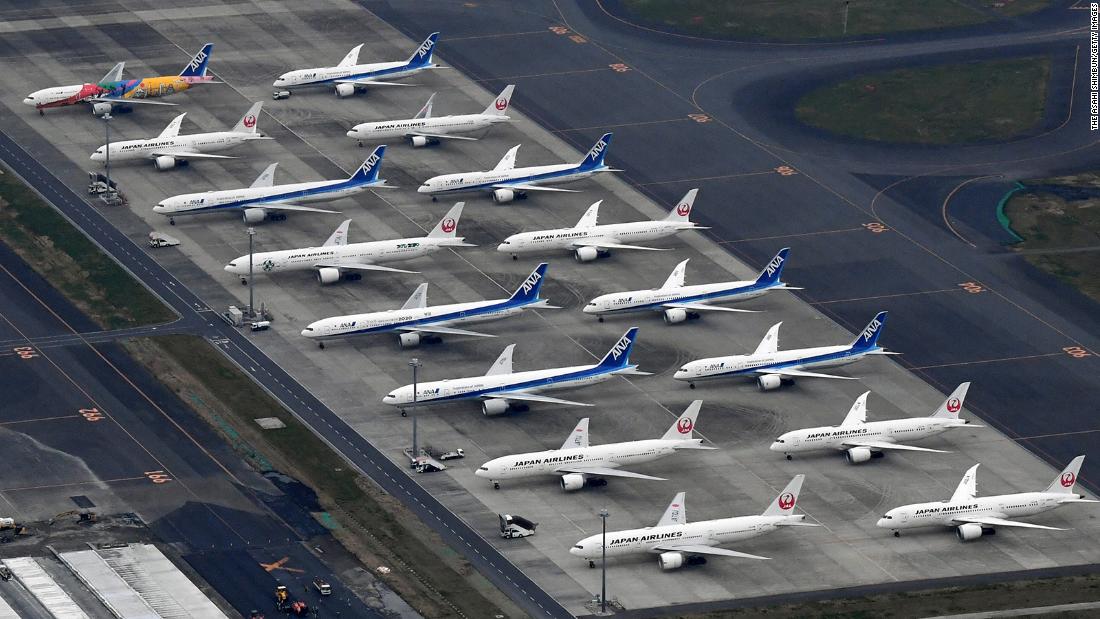(CNN) — It’s the airline that came back from the dead — and then died again.
“The pandemic exposed some of the weaknesses [in airlines] that we might not have seen for some time.”
Prices up, airlines down

As travel restrictions came into force, airports emptied in 2020.
Martin Meissner/AP
2023 has been touted as the year travel finally returns to normal after three years that saw the industry on its knees.
But just when you thought it was safe to get back in the air, the airline bankruptcies have returned.
At the same time, prices are up. Economy fares have increased by an average of 36% for 2023, according to data from Flight Centre, a UK-based booking agency.
Flying to certain destinations has become impossible if you’re on a budget. Fares to New Zealand, for example, have increased 81% year on year, they say, while flights to South Africa from the UK are up by 42% in economy and 70% in business. Of course, there’s context for both destinations. In February 2022, New Zealand was closed and while South Africa was at the center of the Omicron variant.
The Caribbean is suffering the least — just 3% down on 2019 bookings — while Asia Pacific is still lagging at 46% down.
In between are the Middle East (down 5%), Americas (9%), Europe (15%) and Africa (18%).
That’s not set to last, however. Olivier Ponti, ForwardKeys vice president of pnsights, says that he’s “cautiously optimistic that the summer season will be extremely busy” — as long as external factors don’t intervene.
From billionaires to millionaires

Flyr went bust after less than a year.
Joan Valls/Urbanandsport/NurPhoto/Getty Images
Airlines failing is nothing new, of course. There’s an old adage that the best way to become a millionaire is to start an airline… as a billionaire.
But the pandemic has been more damaging to the aviation sector than recessions, wars or terrorist incidents.
A handful have revived after announcing bankruptcy, or changed names, but the vast majority are gone for good.
And while the average traveler might not recognize names such as Jet Time, NokScoot or Fly My Sky, some big names went under in the pandemic, too — for starters, Alitalia, Italy’s former national airline. (The country now has a successor: ITA Airways.) Air Namibia — another national flag-carrier — also went under in 2021.
“I was surprised to see the Alitalia brand go — not because it was in a healthy state, it had been a financial basket case for so long, but because nevertheless it had carried on and on,” says Miquel Ros, AllPlane’s founder and editor.
Ros is sanguine about the bankruptcies. To him, despite the numbers, the pandemic has been less of a Grim Reaper, scything through the world’s airlines, and more a jolt to the industry that made already sputtering engines finally cut out.
“It prompted many airlines that were in a delicate financial situation to give up,” he says.
“Most of those that failed in 2020 were likely to have gone out of business anyway, just a bit later. Many were either airlines that had had issues for quite some time, or fragile ventures that lacked the scale and scope to compete with large operators.”
A lucky escape

Italian flag carrier Alitalia was a high profile bankruptcy in 2021.
Daniel Slim/AFP/Getty Images
“The ones that have gone pretty much would all have gone anyway,” he says.
“Since airlines began, there’s always been a churn. It’s a business with high risks, it’s historically been hard to make money, and it’s very hard to get the business model right. Look at Flybe — its first collapse [March 5, 2020] was, really, before the pandemic. They weren’t making enough money because their business model wasn’t right. That’s probably why they went out of business second time round.”
In fact, Morrison says, most airlines were saved from destruction by governments “putting their airline industries into hibernation, paying their fixed costs and most of the wage bill. They were able to let people go and reduce the cost structure, so though there was no revenue there were lower costs. Very few airlines went under as a direct result of the pandemic.”
He adds that the past three years have seen a “lot of launches,” too. Of course, of those newbies, Flybe’s second iteration and Flyr are already out of the picture.
But it’s not all good news. “The biggest problem has been the recovery — last summer, airports just couldn’t cope with the bounceback in passenger numbers,” he says.
Following the USA

British Airways is one of five airlines owned by IAG.
Steve Parsons/PA Wire/AP
If you’ve flown in the US, you’ll know that choosing your airline is a simpler process than in other parts of the world.
Where in Asia or Europe there are dozens of airlines, both legacy companies and start-ups, vying for your business, in the US there are the “big four”: American, Delta, Southwest and United.
That’s the model that the rest of the world are moving towards as a result of the pandemic, says Pere Suau-Sanchez, senior lecturer in air transport management at the UK’s Cranfield University and the Open University of Catalonia in Spain.
“In Europe, we have more players in our market, they’re generally smaller and they’re generally specialized in terms of geography — so they’re more subject to external forces,” he says.
For him, the bankruptcies are “part of a general trend of consolidation” along US lines. In future, you can expect to see “what seems like fewer airlines” — or regional airlines merging under the same umbrella organization. In Europe, Aer Lingus, British Airways, Iberia, Level and Vueling are already all owned by IAG, for example. Suau-Sanchez thinks this will become more common, with the individual airline names kept on more as “branding to tap into national markets” than showing any real difference.
Regional airports have taken a hit during the pandemic, too, he warns, with airlines concentrating on larger hubs to accelerate recovery. Business travel has taken a huge hit — and business travelers en route to different cities are core clients for regional airports. “When the market is small, losing a few passengers can be a major problem,” he says.
Turbulence ahead

Airlines are currently operating fewer flights — meaning fares are up.
Niall Carson/PA Images/Getty Images
So what does the future hold? Suau-Sanchez thinks fare increases of up to 25% will continue for the “for a few years,” as airlines need recovery money, fuel prices increase, and the aviation industry invests in sustainable technology.
For Morrison, European shorthaul has already stabilized, with decent fares. “Demand is pretty robust, competition is high, and the market is functioning,” he says.
Long haul, though “took a bit more of a battering.” Airlines have yet to restore their pre-pandemic flight schedules — and that means fewer planes and fewer seats.
“It comes down to supply and demand — at the moment the high prices are to do with demand coming back quicker than supply. They can charge a premium for flights, and at the moment longhaul fares are a lot higher than 2019,” he says.
On the plus side, he believes that it won’t be forever: “All being equal, fares will go down. I’m not saying you’ll be able to fly from London to New York for £200 return but I think prices will come down — but over what period I don’t know.”
If it’s round three for the airline, perhaps it’ll be third time lucky.
Note:- (Not all news on the site expresses the point of view of the site, but we transmit this news automatically and translate it through programmatic technology on the site and not from a human editor. The content is auto-generated from a syndicated feed.))



